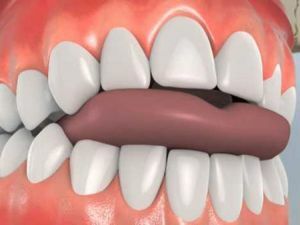 The term open bite is the incorrect closure of the dentition of the upper and lower jaws, in which there is no contact between the front or side teeth.
The term open bite is the incorrect closure of the dentition of the upper and lower jaws, in which there is no contact between the front or side teeth.
Because of this defect in the person in the middle of the mouth a noticeable crevice is formed. About 6% of patients have such an occlusive defect.
Such a malocclusion is not only an aesthetic disadvantage, but also prevents a person from chewing, talking and breathing. Because of the half-open mouth in the oral cavity, the mucous membrane of the mouth dries quickly.
Content
- causes and etiology of disorders
- Varieties open occlusion
- Traumatic OP
- rachitic open bite the child
- Symptoms and Diagnosis
- Functional disorders
- Correction occlusion
- general approach
- Treatment of adult patients
- Retention period
- The consequences and preventive measures
causes and etiology of disorders
There are many factors that accompany the formation of an open bite. Among which the most common are:
- infectious diseases during pregnancy;
- exposure to external factors;
- hereditary factor;
- toxicosis;
- rickets;
- disturbance of mineral balance in the body;
- hypovitaminosis;
- rhinitis;
- curvature of the nasal septum;
- bad habits( nibbling, constant tongue out, sucking various objects and fingers);
- early loss of infant teeth;
- macroglossia;
- problems of nasal breathing( polyps, sinusitis, etc.);
- adentia( absence of teeth);
- physical damage to the jaw( fractures).
With this abnormal development of the dentoalveolar system, a person has a change in the appearance of the face, a violation in the functionality of the oral apparatus.
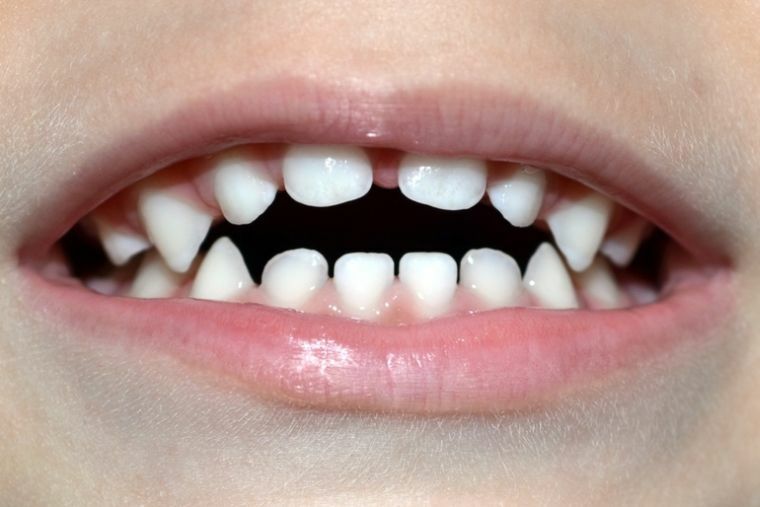
Varieties of open occlusion
For reasons of origin, experts distinguish two varieties:
- traumatic( false);
- a rickety open bite( true, develops in a child still in the womb of the mother).
The open bite is classified according to the location of the defect:
- lateral one-sided and bilateral:
- front( front);
- maxillary;
- of the mandibular;
- mixed.
To determine the possible consequences of open occlusion, there is a grading according to the degrees: 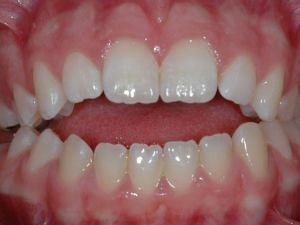
- On the , the initial stage of the development of the gap between the dental arches does not exceed 5 mm in height. The incisors and fangs do not touch each other.
- On the of the second stage of the , the slot has dimensions from 6 to 9 mm. In addition to the front teeth, premolars do not touch( in adults they are behind the fangs in front of the large molar teeth).
- In the of the third degree , the slit has a size of more than 9 mm, there is no clamping on the molars( molars).Defect strongly affects the appearance of the face.
Therefore, a full diagnosis from a doctor may look, for example, as follows: a rickety front maxillary symmetrical open bite of the 1st degree. Such a classification makes it possible to put an unambiguous diagnosis, according to which in the future there will be no questions.
Traumatic OP
This type of open bite occurs in children aged 4-8 years. It is formed because of bad habits:
- to stick out or clamp the tongue between the teeth;
- constantly suck various objects( fingers, toys, etc.);
- gnaw solid objects( toys, blocks, etc.).
It is important to wean the child from bad habits until the baby's teeth fall out. If there is no timely correction, the deformation of the dentition will be fixed and in the future it will be more difficult to get rid of the defect. Call it false, since it appears due to the influence of external factors, the person is completely healthy and only needs to adjust the growth of the teeth.
Ricket open bite in a child
This form of occlusion is treated much more difficultly. Defect arises from the incorrect formation of jaw bones. To restore them, most likely, you will need a surgical operation and the subsequent correction of an open bite with the help of orthodontic devices.
Symptomatics and Diagnosis
When an open bite is observed in a person:
- lengthening the lower third of the face;
- during the smile between the dentition a gap is formed, through which the oral cavity is visible;The patient's mouth is semi-open;
- chin looks crooked, the fold on it is smoothed;
- lips do not close together;
- the upper lip is shortened and from under it the tongue with the edges of the upper teeth can be seen.
 Sometimes patients constantly tighten their lips to hide a defect, such changes can be determined by the characteristic features of the cheeks( always tense, the skin over them is stretched).Aesthetically, the face looks unattractive, which causes discomfort to a person and it has various complexes in this regard, especially among girls.
Sometimes patients constantly tighten their lips to hide a defect, such changes can be determined by the characteristic features of the cheeks( always tense, the skin over them is stretched).Aesthetically, the face looks unattractive, which causes discomfort to a person and it has various complexes in this regard, especially among girls.
If an open bite was formed due to bad habits, the gap between the dentition lines in outline will resemble an object that the child regularly sucked, chewed or held in the mouth.
Because of the heal location of the front teeth there are:
- frequent caries formation;
- refined enamel;
- uneven borders of teeth;
- rapid formation of plaque and calculus;
- bleeding and swelling of the gums;
- deformity of the upper palate.
If an open bite is formed due to problems with the nasal cavity, the person often breathes through the mouth due to lack of air.
Functional disorders
Because of the altered palate and dental arch, it is difficult for a patient to pronounce phonetically correctly the labial [B, P, B, F, M] and linguistic [C, M, L, R, L], etc. sounds. Since the language slips into the slot during the conversation, the speech is muffled. Because of the difficulty in articulating the tongue, the patient's facial expression is compromised. 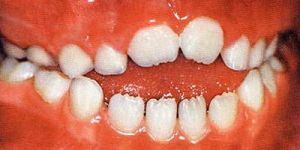
Also a person experiences discomfort during chewing and biting food. Since the effectiveness of chewing decreases, it can lead to periodontal disease and dysfunction of the TMJ.
The first task of diagnostics is to determine the factors that led to the anomaly. For this purpose:
- photometric examination of the face;
- study of models and orthopantomograms of jaws;
- lateral TRH( telerrogenorhamma).
Based on these studies, determine the shape of the bite. In the future, these data are used to install bracket systems and other orthodontic equipment.
Correction of occlusion
To correct an open bite, first determine the severity of the anomaly, as well as the age of the patient. By age, the methods of treatment are determined, since in childhood, until molars have appeared, the bite can be corrected with the help of myogymnia( most effective in 4-7 years).
General approach
For all ages, in the treatment of open bite, special exercises are used to train the jaw and dental muscles of the 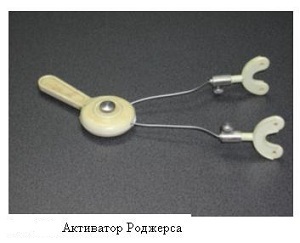 ( round, square, cheek, chin, zygomatic, laughing, triangular).To better train the muscles use:
( round, square, cheek, chin, zygomatic, laughing, triangular).To better train the muscles use:
- activator Rogers;
- activator Dassa;
- widening plates with screws, hinges and springs.
If the patient has problems with nasal breathing, they also need to be cured so that the person does not breathe through the mouth.
After correction of bite defects, to fix the patient's result, crowns, kapy or retainers, braces are installed. Also can use the apparatus of Schwartz, or Gerbst.
Treatment of adult patients
Unlike children in adults after 16 years, the dental jaw system is formed and for correcting its defects, some exercises will not be enough. Therefore, the first stage of treatment consists in preparing a person for the installation of braces, for this use active equipment for correction of occlusion( Distal Jet or the like).This device moves molars to the desired position.
Almost always with an open bite after adjusting the position of the teeth, an adult patient is placed with braces. If the jaw bone changes can not be corrected by the above methods, the person is offered to perform the operation. It is called orthognathic, it is performed by the maxillofacial surgeon.
The doctor cuts the soft tissue and finds the wrong bone. Further it is sawed and the extra bone tissue is cut out by triangles. After corrective actions, the jaw is fixed by means of metal plates. Depending on the characteristics of the patient, the operation can be performed by different methods.
All of the above methods are used to correct the occlusion and in children. Except that they do not always use additional equipment. After reaching the age of 8, orthodontists can install a double block system or other auxiliary devices to correct the position of the jaw.
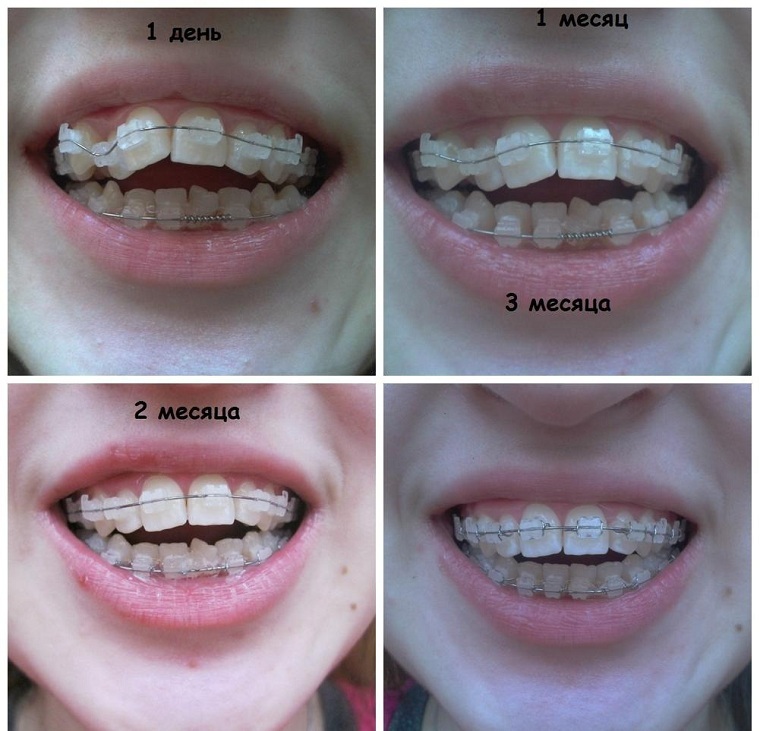
In the picture, the patient is diagnosed with an open bite before and after braces treatment.
Retardation period
. If a person is operated, the first 7 days he is on in-patient observation. The recovery period lasts 2 months, but in addition it takes time to restore the functionality of the jaws( 12-15 months).
If treatment was performed without surgery, but only with the help of braces, then a full recovery will take 1-2 years.
Consequences and preventive measures
If the treatment of open bite is not started in time, the patient will later have to undergo an operation and undergo a long recovery period.
After correction, the majority of functional defects disappear in humans. However, sometimes a plastic surgery may be required to give the face a normal appearance.
In order for a child not to develop occlusive defects, special attention should be given to the health of a woman during pregnancy. A future mother should lead a healthy lifestyle and strengthen her own immunity throughout pregnancy. Since the mother's diseases during this period affect the further health of the baby.
After the birth of the child, you need to follow it regularly so that the baby does not develop bad habits. It is especially important to observe the correctness of the articulation of the tongue during conversation and swallowing. In early childhood, preferably 1-2 times a year to visit the orthodontist.
